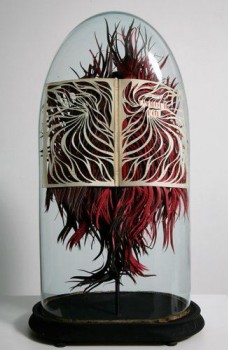Georgia Russell

© Galerie Dukan et Hourdequin
GR : A book called Mémoire. I was in Paris on a residency with the Royal College and I was working on a video piece about changing light in Paris. Whilst walking along the Seine I noticed the bouquiniste stalls. I enjoyed seeing the juxtapositions of authors thrown together such as a Proust next to Paul Auster. I bought some books to start to play with these juxtapositions and also to use as simple sketchbooks. I started cutting and collaging the books and eventually moved from scissors to scalpel. I began transforming the books into forms I wouldn’t have conceived beforehand.
Many of the books you have transformed make reference to feminine intimacy. I can think of Studies on Hysteria, le Deuxième Sexe or many other emblematic novels like Madame Bovary. Is there an intention to explore this particular thematic ?
I started reading these books as a foreign student in Paris. I was interested in different viewpoints on life and was in a much more culturally diverse city than I had been used to in the past. Through these books i could see how opinions differ and mutate as time progresses. I am convinced by the idea that a book can adapt to its reader. It has the power to transform, and at the same time the reader is able to project himself into it.
Is it to represent the impact books bestow over the reader’s interiority that you make them resemble inner organs like a lung, a heart or the nervous system ?
Once open, the book is the space where you can have very intimate relationships with characters or authors. When I intervene with my scalpel, in a slow and rhythmical manner the book becomes a kind of trophy for time passed and emotions provoked.
They also resemble totems or masks,
The idea of Masks and Totems are evident when we look at some of my work. Totems are symbols of belief, ancestry, protection and guidance. They were used to make the physical world a comprehensive and coherent classificatory system. Like books or images are for us today. The function of masks may be magical or religious; they may appear in rites of passage or as different characters in theatre. Masks watch over important ceremonies; they help mediate with spirits and offer a protective role to the person who wants to use their powers.
I was surprised to see that in the past you have also worked with newspapers, can you explain ?
Newspapers are like mirrors of our society but in fastforward. There is so much information everyday, always changing and evolving. Sometimes I feel like halting the production, to kind of slow-down time and prevent disater. My piece A Story of Art expresses how a long period of time can be condensed into one small physical space and can be glossed over so quickly.
Many Surrealist books have also gone under your blade, Manifesto, Nadja or De Baudelaire au Surréalisme. What is your attraction to Surrealism ?
Firstly I identified with their aesthetics, the transformation of objects and visual and text based collage work. Upon closer inspection I found Claude Cahun particularly interesting. I enjoy her vision on subjectivity which she sees as mobile, multiple and recreated moment by moment. Quote, we try to delineate our roles, she writes, according to our changing moods. It is only after many attempts that we can firm up the moulds of our masks. We can firm up our identity, she suggests - but it will only ever be a mold, or a mask. She was deeply influenced by Rimbaud who declared that Je est un autre (I am another), Cahun replies, Je est un autre - un multiple toujours (I am another - always multiple). This has helped me clarify what I try to communicate in my work.
Looking now at your landscapes and figurative pieces. The landscapes for this exhibition are taken from the Musée d’Orsay collection, but with the figurative pieces you have worked with models in a studio and a photographer, why the difference in approach ?
I am fascinated by old photography, in particular the Daguerreotype and enjoy visiting the past with them. By enlarging and then incising the photos I feel as though I’m going back in time and visiting that place in detail. This we know is impossible, just as we know that these wild and luscious or peaceful and natural landscapes are disappearing as time advances. For me, the figurative pieces are more about the present. The fact that I know the models charges the images for me, making them a heightened present in contrast. Again I think I’m trying to freeze time and halt the inevitable disappearance of being.
Your method of cutting with a scalpel is rhythmical and meticulous, is this a way of spending more time with an image ?
The incisions indicate time spent. The repetitive method makes minutes, hours and even days tangible ! There is a physical result of time spent with someone, something or somewhere. I often push the cutting to its limits of representation, so that things become almost non-existent. For me I’m drawing things towards nonexistence and freezing them at different intervals towards their destruction.
The frontier between making an artwork and its destruction makes me think of The Unknown Masterpiece by Balzac, which you have also used in your work.
I feel as though I draw with my scalpel, and instead of drawing in positive, I draw in negative. Like drawing backwards. So I suppose I erase what is already there, leaving a trace of what was. When drawing or painting we try to find the perfect mark or line, with cutting I try to leave that line or stroke behind, the rest is irrelevant.
Interview with Georgia Russell, april 2010. For the exhibition catalogue, Dukan& Hourdequin Gallery.
Marguerite Pilven


